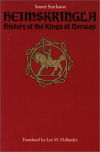Heimskringla: History of the Kings of Norway
Last updated: 17.12.19

| Printed: | 1991 | Author: | Snorri Sturluson |
| Publisher: | University of Texas Press | ISBN: | 0292730616 |
| Suppliers: | 






|
Paperback: 854 pages, usually ships within 24 hours.
Amazon Review
Reviewer: A reader
This book starts in the age of the Roman empire. Odin, a king from the mountains of Caucasus in the south-eastern corner of Europe went forth to settle in Europes northernmost parts, as he thought (correctly) that this region would be spared of Roman rule. Other historic sources tell us that people had settled Scandinavia for more than 10 000 years at this point, but the Saga claims that Odin's heirs came to dominate Northern culture and politics from this point on, and seing Odin as the highest of a number of Gods.The book shortly describes how the heirs of Odin created united Kingdoms of Denmark and Sweden, while Norway remained a region of quest for the Swedish kings as well as for the local Kings of Norway.From this point on the book is exclusively concerned with the history of the Kings of Norway. The most important features of the book is how King Harald Fairhair came to unite Norway under his rule some time in the 9th century. How the Danish kings accessed power in Norway as a result of the disputes between Harald Hairfairs heirs. Then how Olaf Tryggvason, an exiled hair of Harald Hairfair, returned from England, seized power, and forced Christianity upon the people by means of threats and occational torture. The most important part of the book, in my view, is about Olaf the second, St'Olaf. He finished the process of christianization by the same harsh premises as his predecessor, hence becoming unpopular. When the expansive Danish king Knut laid his eyes on Norway, the Norwegians merely give it over to him. Olaf, fled, gathered a partly foreign force in Sweden with which he attempted to take back his rule. However, he fell in the attempt, making for one of the most grandiose northern battles in the process.The significance of St'Olaf however, is not his (lack of) success, but his eventual symbol value. The Norwegians shortly after learned to hate the Danish rule, and regretting their resistance to Olaf. Rumors started to spread that signs and miracles happened at Olafs grave, inspiring the revolt by which the Danes were eventually overthrown.From this point (1033), Norways fortunes as a nation multiplied, and the latter part of the book delves into that. In the centuries following this book however, Norwegian civilization would diminish. Partly so because of the heaviest black death (1349) toll of any European country, 2/3 of the population. Partly because of a climatic change to the colder. Norway came under Danish, then Swedish rule and did'nt regain independence until 1905. Since Norway today is so disconnected from its distant past, it is crucial to be reminded of its historic role in order to understand the history of the region as a whole.

